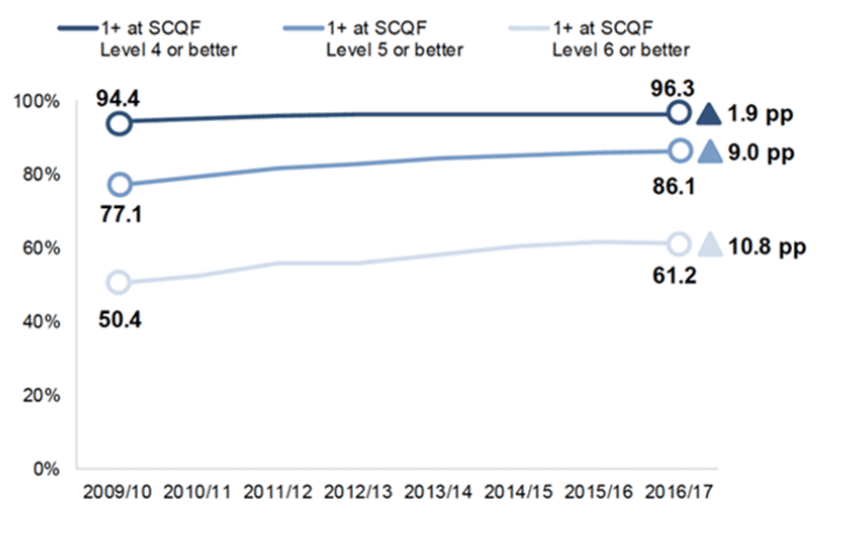Children's Health and Wellbeing - Horizon Scanning Review
The review summarises the predicted societal trends and shifts that will likely shape the lives of children and young people over the next decade.
5. Education
This section describes current trends in education in Scotland, as well as global future trends. The current trends section highlights attainment changes, while the future trends section highlights how digital technology and the labour market are expected to influence a variety of aspects of education.
5.1 Current trends in Scottish education
The percentage of Secondary 4 pupils staying on to Secondary 6 in publicly-funded secondary schools in Scotland increased from 46% in 2001 to 59% in 2013. Attainment of qualifications also increased across SCQF levels 4, 5 and 6 from 2009/2010 to 2016/2017 (Figure 14).[26] However, a gap remains in attainment of SCQF level’s 4, 5 and 6 based on SIMD. The largest gap exists between pupils achieving one or more SCQF level 6 qualification, with the most deprived achieving this at a rate of 43.0% compared to 80.6% for the least deprived (Figure 15).[27]
Figure 14. Attainment of qualifications across SCQF levels 4, 5 and 6 from 2009/2010 to 2016/2017
Source: Attainment, leaver destinations and healthy living 2018
Figure 15. Percentage of attainment of SCQF level 4-6 by SIMD 2015/16 and 2016/17.
Source: Attainment, leaver destinations and healthy living 2018
Higher education
The number of students in Higher Education Institutions and colleges has increased over the last decade (see Figure 16). There were increases in both first and postgraduate degrees, and also in HNC/HNDs, with a small drop in sub-degree qualifications.[28]
Figure 16. Students in Higher Education at Scottish HEIs and Colleges by Level of Study, 2006-07 to 2016-17

Source: Attainment and Leavers Destinations Data 2016/17
The percentage of school leavers in Higher Education 9 months after leaving school has also increased over the last decade, from 34.2% in 2009/10 to 38.3% in 2016/17. Figures prior to 2009/10 are not directly comparable due to a change in methodology.
As noted in Chapter 3, there is some evidence that the increase in young people educated to degree level may be accompanied by increased requirements from employers for such qualifications.
5.2 Future trends in digitally-delivered education
Digitally-delivered education is likely to provide an increased degree of personalisation, with students able to customise when, where and how they learn. Education courses, particularly at tertiary level, will likely depend increasingly on the internet, with some delivered exclusively or almost exclusively online. As data science advances, developing data analysis and computing skills will likely become central to our education system. As school teaching increasingly moves online and software-based in nature, existing educational inequalities could be exacerbated, as not everyone will have the same level of digital access. However, it is likely that online learning will continue to make education more accessible, particularly for people in remote rural areas.[30]
5.3 Key points
- More pupils in Scotland are staying in education for longer and are gaining more qualifications as a result.
- There remains a large gap in attainment between pupils from the most and the least deprived areas.
- A higher percentage of young people are enrolling in higher education in Scotland.
- Digitally-delivered education is likely to provide increased levels of personalisation, with students able to customise when, where and how they learn.
- As data science advances, developing data analysis and computing skills will likely become central to our education system.
Contact
Email: socialresearch@gov.scot
There is a problem
Thanks for your feedback